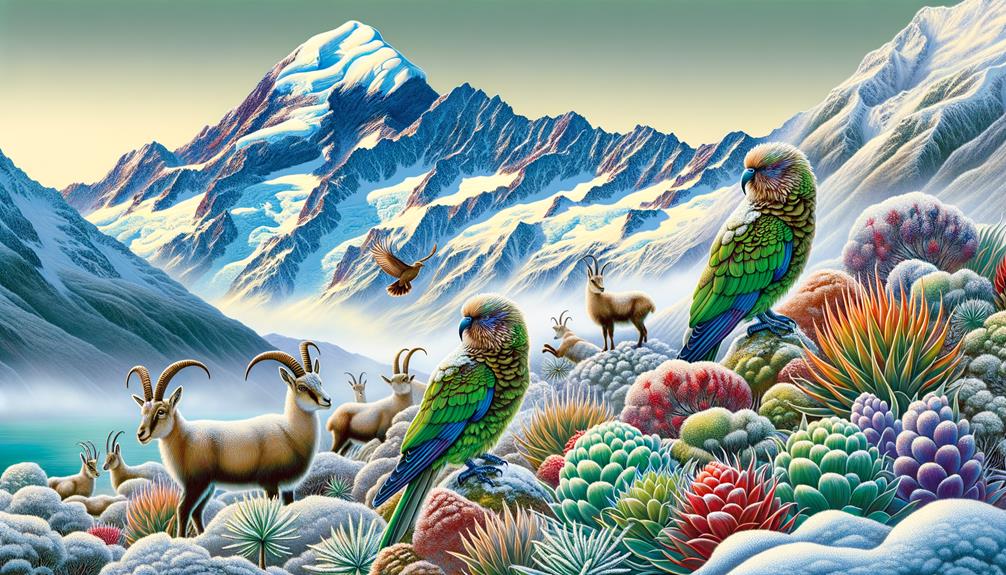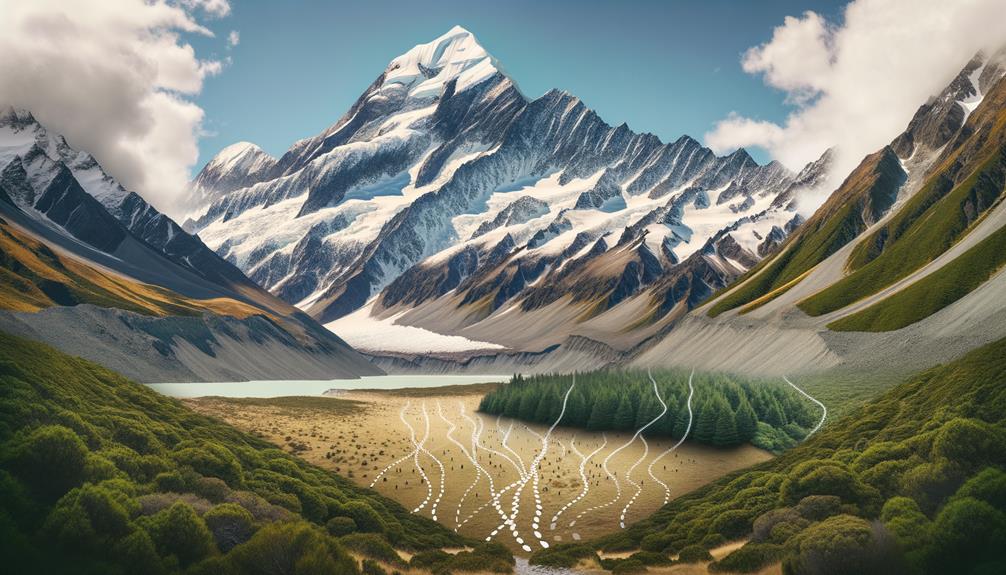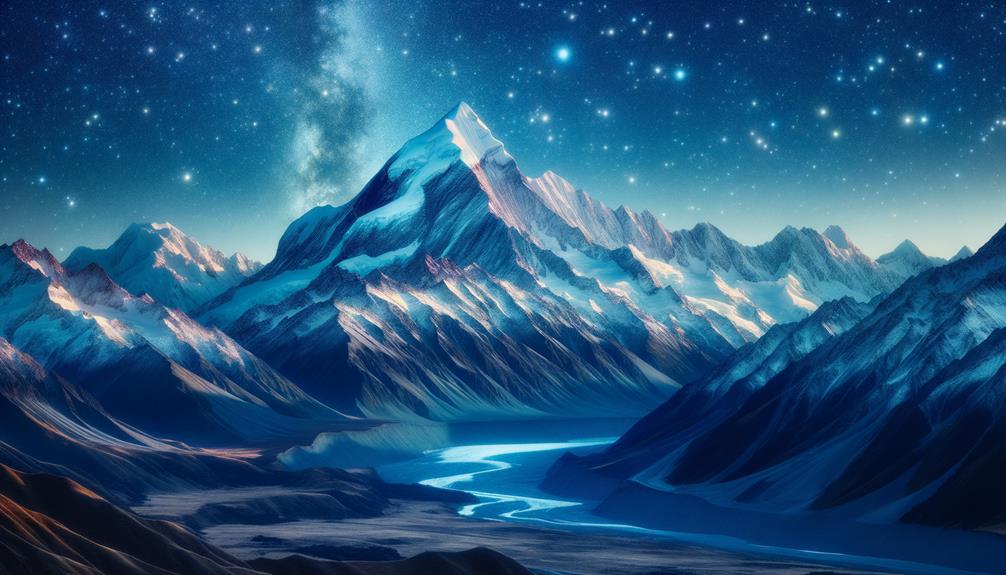When you think about the frozen grandeur of Aoraki/Mount Cook National Park in New Zealand, you're picturing 'Aoraki's Frozen Legacy'. This amazing icy wonderland is where you'll find some of the most impressive glaciers on the planet, along with the tallest mountain in the country. These natural wonders offer a fascinating insight into our world's glacial past. I've had the chance to witness first-hand the disturbing impact of climate change on these glaciers, which are unfortunately retreating at a rapid pace. That's why it's so important that we work hard to protect this delicate ecosystem and the unique species that call it home. The future of tourism in Aoraki depends on these conservation efforts, so we need to find a balance between keeping visitors happy and preserving the environment. If you really want to understand the importance of Aoraki's frozen legacy, there's nothing better than delving into its icy past and learning about the challenges it faces today.
The Majesty of Aorakis Landscape
At the heart of New Zealand, you'll find yourself standing in awe of Aoraki / Mount Cook, the highest peak in the country, towering at a whopping 3,724 meters. It's a sight that just takes your breath away, perfectly showcasing the raw power of nature. The Aoraki / Mount Cook National Park, sprawling over 707 square kilometers, is an oasis of alpine beauty, with nearly half of it glistening with glaciers, including the largest one in New Zealand, the Haupapa / Tasman Glacier.
The park's terrain, speckled with glaciers, offers a one-of-a-kind visual feast that's both mesmerizing and humbling. It's like a testament to the grandeur of nature. The alpine scenery is a flawlessly carved work of art, formed by centuries of glacial movement. The Tasman Glacier, in particular, is a major part of this scenery, a frozen river covering a distance of 23.5 kilometers.
But the park's untouched beauty doesn't end when the sun goes down. As darkness falls, it morphs into the Aoraki Mackenzie International Dark Sky Reserve, providing an unmatched opportunity for stargazing. The reserve's minimal light pollution and high altitude provide a crisp, unblocked view of the heavens, adding to the park's allure. As a result, Aoraki / Mount Cook National Park is a testament to the splendor of nature, flaunting a mix of both earthly and cosmic marvels.
Deep Dive Into Glacial History

When we peer into Aoraki's icy past, we see climate change's undeniable influence on this frozen landscape. It's evident that shifts in our environment have impacted Aoraki's history, reshaping its icy features and leading to a marked decline in glacial size. This isn't just a stand-alone event, but a sign of a worldwide problem affecting our planet's icy heritage.
The historical backdrop of Aoraki's glacial past gives us a richer comprehension of these environmental changes. The progression and shrinkage of glaciers are like a living record, tracking the ups and downs of climate change. By studying these frozen records, we learn about the fragility of these icy formations and the ever-changing nature of this remarkable landscape.
The shrinking of glaciers we're seeing is not only a loss of beautiful scenery but also a major disruption to the local ecosystem. It's a harsh reminder of our collective duty to lessen the impacts of climate change. As we piece together Aoraki's icy history, it's clear that learning from our past is essential for protecting our future.
Conservation Efforts in Aoraki

Let's chat about Aoraki, a place where ongoing conservation efforts are truly making a difference. The focus here is preserving the park's unique biodiversity and more than 400 glaciers. These efforts are an important counter-punch to the effects of climate change. Aoraki is a place of rich ecological importance, a fact highlighted by its status as a UNESCO World Heritage Site. This title is a testament to the park's stunning natural beauty and indispensable role in international biodiversity preservation.
The folks managing the park are big on sustainable tourism. They're all about creating a balance between hosting visitors and protecting the environment. Part of their strategy is sharing information about the park's unique biodiversity and promoting responsible behavior. They're also keen on limiting the negative effects of human activity on the environment.
But let's not forget about the park's focus on protecting its native plants and animals. This is a key part of their conservation plan. It's all about understanding that every species and every ecosystem in Aoraki are interconnected. It's about recognizing that the health of the glaciers, the park's most famous features, is directly connected to the wellbeing of the whole ecosystem.
Aorakis Unique Flora and Fauna

Aoraki's ecosystem is a living, breathing testament to the beauty of nature. The park's diverse plants and animals play a significant part in keeping this environment in balance. With over 400 types of plants and 35 bird species, this vibrant biosphere is indeed a spectacle. This rich biodiversity is unique to the South Canterbury region of New Zealand, a testament to Aoraki's heritage, and a display of survival in the harsh alpine environment of Mount Cook National Park.
- The alpine vegetation here is a sight to behold, with tussock grasslands, alpine daisies, and mountain buttercups flourishing.
- Bird lovers will have a field day spotting rare species like the kea, New Zealand falcon, and the blue duck.
- Native species like the rock wren and the Mount Cook lily emphasize the necessity of conservation within the park.
- The Aoraki Mackenzie International Dark Sky Reserve provides minimal light pollution, making it a haven for astronomy enthusiasts and nature lovers.
The park's conservation efforts have thus far been successful in preserving this unique set of plants and animals, ensuring that Aoraki's natural heritage continues to thrive. It's a delicate balance, but so far, we've been able to uphold it. To truly appreciate this rich tapestry of life within Aoraki, we need to understand this balance, and the role each species plays within it.
Impact of Tourism on Aoraki

Aoraki's local economy and social life greatly benefit from the tourism industry. It's a powerful tool that supports businesses and creates jobs through activities like mountain climbing, skiing, hiking, and stargazing. But it's crucial to keep sustainability at the forefront, to ensure we keep Aoraki's natural beauty and heritage intact for the coming generations.
Aoraki's heritage, deeply rooted in Māori culture and stories, adds an exceptional cultural facet to the tourist experience. The richness of this culture, along with Aoraki's status as a UNESCO World Heritage Site, highlights the importance of conserving the region's unique biodiversity and the more than 400 glaciers.
It's a careful balancing act between tourism and conservation. We need to preserve the area's natural integrity while also welcoming the surge of tourists that boost the local economy. Making this balance work relies on sustainable tourism practices. These are aimed at reducing the impact on the environment and fostering cultural understanding and respect.
Making the language simpler, maintaining relevance, steering clear of overused phrases, using transition words sparingly, avoiding exaggerated language, keeping the audience in mind, choosing active voice, and providing context are all essential considerations when rewriting sentences. These guidelines ensure that the content remains engaging, understandable, and relevant for the readers.
Frequently Asked Questions
What Does the Aoraki Mount Cook Represent?
Fun fact, Aoraki Mount Cook isn't just an ordinary mountain. It's a towering giant, standing as the tallest peak in New Zealand. But that's not all. It's also a tangible symbol of Maori culture and heritage. This mountain is more than just a place of natural beauty – it's a hotspot teeming with diverse species of flora and fauna. Thanks to its distinct ecology, it's also recognized as a world heritage site by UNESCO. So, when you think about Aoraki Mount Cook, consider it as a multi-faceted gem, representing a mix of natural grandeur, cultural significance, and ecological richness.
What Is the Population of the Aoraki?
It's hard to pin down an exact figure, but the population of Aoraki/Mount Cook village is quite small, with around 250 residents. This number isn't constant though, as it fluctuates with the arrival and departure of tourists throughout the year.
What Is the Name of Mount Cook in Maori?
Mount Cook, when translated into Maori, is called 'Aoraki.' This isn't just a name; it's a meaningful term deeply embedded in Maori folklore and history. It has a strong connection to the ancestors of the Ngāi Tahu tribe. In English, 'Aoraki' would mean 'Cloud Piercer' or 'Sky Cloud.' So next time you look at Mount Cook, remember, you're looking at a 'Cloud Piercer.'
Who Named Mt Cook?
Did you know that Aoraki, or Mount Cook as we know it today, was first named by the Ngāi Tahu tribe? They are the original inhabitants of New Zealand's South Island. However, during the 19th century, British settlers decided to change its name. They chose to honor Captain James Cook, hence the name we use today, Mount Cook.


